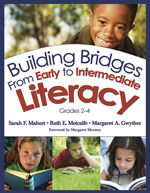Building Bridges From Early to Intermediate Literacy, Grades 2-4
- Sarah F. Mahurt - Purdue University, USA
- Ruth E. Metcalfe - Literacy Coordinator, Goshen Community Schools, IN
- Margaret A. Gwyther - Educational Consultant, Texas
Foreword by Margaret Mooney
Ricardo Richards Elementary School, Kingshill, Virgin Islands
'Full of practical, everyday ideas to implement immediately. Offers true student examples that teachers see and experience daily'—Scott Kovatch,
Principal Horizon Elementary School, Granger, USA
How can teachers help their primary students become competent intermediate readers and writers?
Supporting students as they advance from beginning to intermediate literacy levels poses a unique challenge for teachers. In Building Bridges From Early to Intermediate Literacy, Grades 2–4, Sarah F. Mahurt, Ruth E. Metcalfe, and Margaret A. Gwyther show how teachers can meet the instructional needs of students in transition from one level to the next. The authors offer practical guidance and classroom-tested strategies that demonstrate how thoughtful instruction can help each student reach new levels of competency in reading and writing.
This invaluable resource shows teachers how to examine and refine their instructional practices to more effectively meet the needs of all the students in their classrooms, whether they are struggling readers or advanced learners. Educators will find:
- Specialized assessment tools and
instructional strategies for word study,
reading, and writing
- Detailed examples of reading and writing
instruction
- Methods for integrating language arts
with science and social studies
- Charts to track students' progress
- A teacher's reflection section at the end
of each chapter
Written by experienced literacy educators, this accessible text helps ensure that all students confidently cross the bridge from the primary to the intermediate grades.
"Full of practical, everyday ideas that can be implemented immediately. The examples in the book were something that teachers see and experience daily—true student examples."
"Keeps the essential questions and a clear road map in front of teachers and administrators as they strive to implement balanced literacy in their schools. By outlining critical questions and critical observations of elementary readers, the authors prepare teachers to make the necessary shifts in their teaching to help students transition to independent reading and writing."
"This book is easy to read and full of practical ideas that I can use as a literacy coach and as a classroom teacher."
"This book gives us an inside view of what children should experience in the primary grades and shows us how we can build them up to new experiences in the intermediate grades. This book would be a great resource for vertical team collaborations, teachers who are transitioning from teaching primary to intermediate grades or vice versa, teachers in multi-age classrooms, and teacher education classes."
"Hits the nail on the head. A quick and comfortable read, this book addresses the issues of transitional learners who are often stuck in the middle on their journey from needing high levels of teacher support to independent learning. With explicit language and examples, this book gives us a window into what a transitional classroom looks and feels like.”
"Chapters have been tested by experienced literacy educators and offer a fine synthesis of techniques that work."
